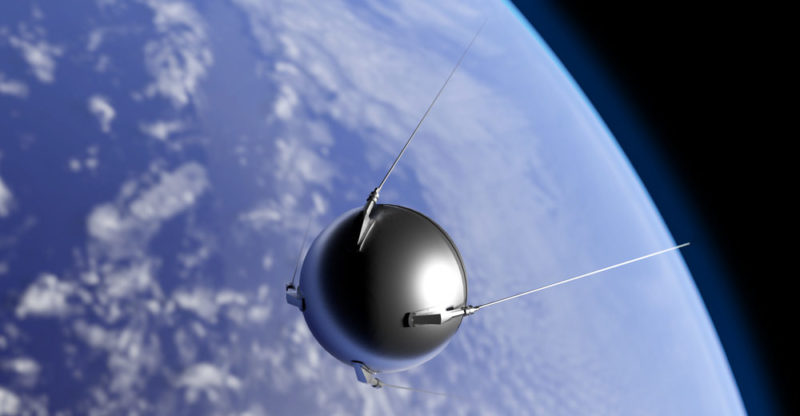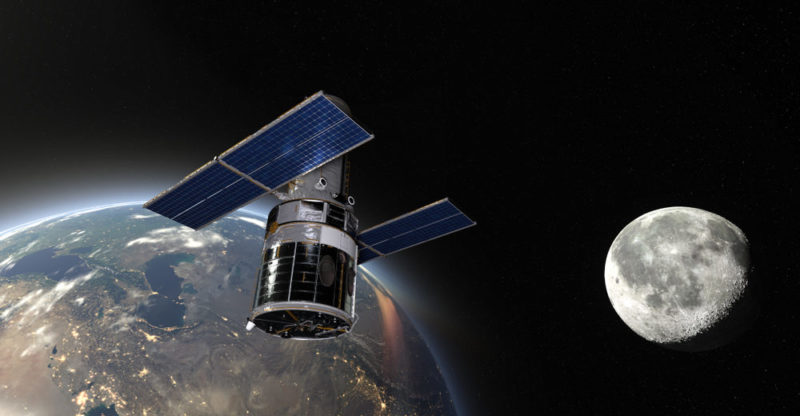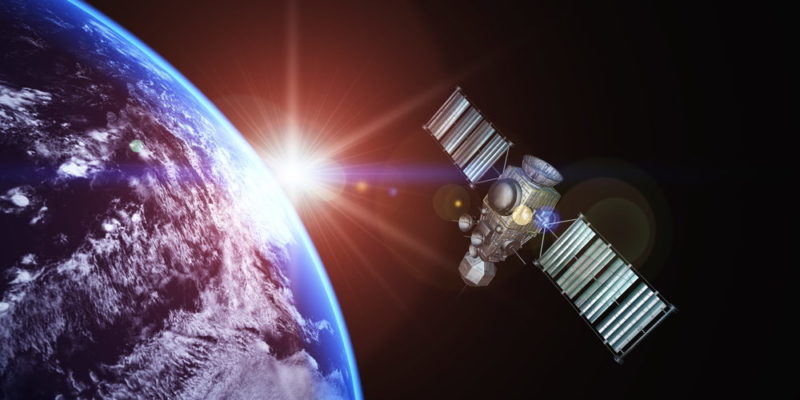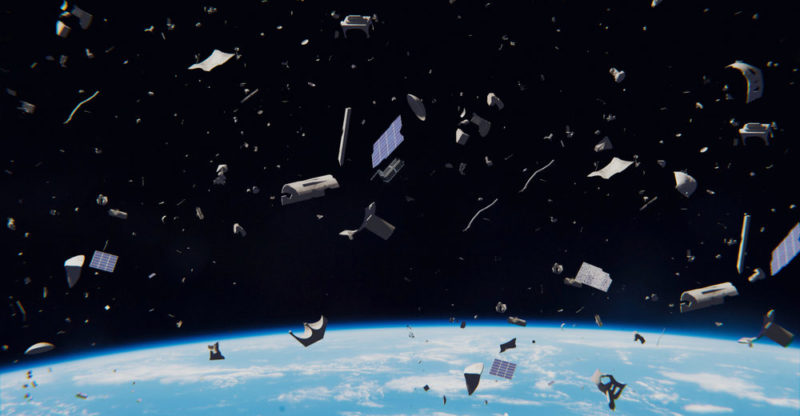We explain what artificial satellites are and the types of satellites that exist. Also, what are its general characteristics and functions.
What are artificial satellites?
Artificial satellites are objects that human beings manufacture and launch into outer space with the aim of orbiting a celestial body (a planet ) or a natural satellite (for example, the moon ). They differ from natural satellites, which are celestial bodies that orbit around a planet.The purpose of these satellites is to obtain certain useful information about the celestial body or natural satellite that they observe. The satellites that orbit the planet Earth are used to improve telecommunications , since they broadcast signals and allow the operation of telephones , the Internet and digital television . They are also used to generate weather reports and obtain information on the earth's surface.
Satellites are launched into space and must pass through the Earth's atmosphere and achieve orbit around a celestial body , which is usually the Earth. Once there, they must follow a certain route depending on the objective they have. The satellites have an energy recharge that allows them to extend their useful life. However, after power depletion, the satellite is discarded into outer space as space junk.
The first artificial satellite and the space race
 The first space satellite was launched in October 1957 by the Soviet Union and was called Sputnik I. His goal was to collect information about the highest layers of the atmosphere.
The first space satellite was launched in October 1957 by the Soviet Union and was called Sputnik I. His goal was to collect information about the highest layers of the atmosphere.This occurred within the framework of the space race that began in the mid-1950s , between the United States and the Soviet Union, whose objective was space exploration with the development of satellites and the sending of human beings into space. The United States managed to send its first artificial satellite, called Explorer I , in 1958 and one of its greatest successes was the discovery of the Van Allen belts.
Subsequently, other countries managed to place artificial satellites in Earth's orbit. It is believed that there are currently almost 5,000 satellites orbiting the Earth and more than half are already inactive and constitute the so-called space junk.
Due to the scientific development and the necessary financial support, few countries in the world sent satellites into space. Those who lead the list of shipments are: Russia, the United States, France , Japan and China .
Characteristics of artificial satellites
 The main characteristics of artificial satellites are:
The main characteristics of artificial satellites are:
- They are created by humans . Satellites are launched for a specific purpose that varies from case to case.
- They usually orbit the planet Earth . Most of the satellites that are built are used to obtain information about the planet Earth or fulfill certain purposes that contribute to human and social development.
- They can be spherical, cylindrical or conical . Inside they have materials of high delicacy and sensitivity.
- They can be observed from Earth . The most suitable times are two hours before sunrise and two hours after sunset .
- They can be scientific or applied . Scientific satellites have the function of studying space, radiation or the planets, and applied satellites have a specific function on Earth, such as meteorological observation, military espionage or telecommunications.
- They are made up of certain fundamental parts . Satellites are made up of: solar panels, which absorb solar energy and convert it into electrical energy (in some cases they can be made up of batteries); antennas, which are responsible for transmitting and receiving information; a control center, which processes the stored information, and a camera or mechanism that collects information.
- They must have a route or path to follow . When a satellite has a path around a planet, it is called an orbit. If this orbit is elliptical, it will have a farthest point called "apogee" and a closest point called "perigee".
- They can be active or inactive . Satellites have a certain useful life, so after a while, or due to certain factors, they fall into disuse. In some cases they remain in Earth orbit as space debris, but in others they can re-enter the atmosphere, where they disintegrate and return to Earth.
- They are launched in a rocket . In order to place a satellite that orbits the Earth, a powerful drive mechanism is needed, since the satellite must reach a speed of 8 km per second. For this, it is necessary to build a rocket that has the satellite inside, which it will drop once the desired location is reached.
Types of satellites
 Satellites can be classified according to two main criteria:
Satellites can be classified according to two main criteria:According to its purpose:
- Communication satellites . They are satellites that help transmit the signals necessary for telecommunications. They usually broadcast television and radio signals from one point to another. The first such satellite was Telstar 1 .
- Weather Satellites . They are satellites used to evaluate, measure and predict climatic conditions on Earth. The first such satellite was Tiros-1 , launched in 1960.
- Navigation satellites . They are satellites that are used to know the precise and exact position of something or someone on Earth. They are, for example, those used by the GPS, Galileo and GLONASS systems.
- Reconnaissance Satellites . They are better known as spy satellites and are used in the military or in intelligence services.
- astronomical satellites . They are satellites that are manufactured to observe galaxies , planets, asteroids or other astronomical objects.
- Solar powered satellites . They are satellites that serve as a power source. They receive energy from the sun and redirect it to the antennas of homes on Earth.
According to the type of orbit:
- Low Earth Orbit . They are satellites that are located a short distance from the earth's surface, between 700 and 1400 km, and their orbital period is between 80 and 150 minutes.
- Mean Earth orbit or intermediate circular orbit . They are satellites that are located between 9,000 and 20,000 km and their orbital period can be between 10 and 14 hours.
- Geostationary orbit . They are satellites that are 35,786 km away from the equator . These satellites always remain on the same place on Earth, that is, they do not rotate.
Space junk

After its useful life or the collection of necessary data, an artificial satellite can be left orbiting a celestial body without any use . Therefore, it is said to become space debris.
Space debris is often a risk to spacecraft launched from Earth into space, because these loose satellite debris can damage or destroy them.
If the satellite is low, it can disintegrate and enter the Earth's atmosphere in pieces.
Importance of artificial satellites
Artificial satellites that manage to position themselves in Earth's orbit are essential for the development of the human species and life in society . They are used both in the field of scientific research and development, as well as in telecommunications and meteorology .
On the one hand, satellites are used for scientific research since many of them are sent into space with the aim of exploring other planets or bodies and detecting meteorites . In addition, they allow observing life on Earth and studying phenomena such as deforestation , different types of relief , sea level , pollution and exploring inhospitable regions or regions difficult to access for humans.
Satellites are essential to obtain useful information, such as climate data at a specific point on the planet or that necessary for the preparation of maps. They are also responsible for the development of GPS-type technology that allows knowing the almost exact position of any object on the earth's surface.
Artificial satellites are of great importance in the field of telecommunications because they transmit messages and information from one point on the planet to another . Communication satellites send and receive signals that allow the development of technologies and means of communication such as television, radio, cell phones and the Internet.
Natural satellites
Unlike artificial satellites, which are created by humans, natural satellites are those that exist naturally in space .
Natural satellites are celestial bodies (objects located in space) that orbit around a planet (although bodies that orbit around other celestial bodies are also often called satellites). The most recognized case of a natural satellite is the Moon , which is the only natural satellite that orbits the planet Earth. In many cases, the term moon is often used as a synonym for natural satellite.
Other natural satellites are: the four main satellites of Jupiter : Io, Europa, Ganymede and Callisto; the largest satellite of Saturn : Titan; the two satellites of Mars : Deimos and Phobos; and the main satellites of Uranus: Titania, Miranda, Ariel, Umbriel and Oberon.
The above content published at Collaborative Research Group is for informational and educational purposes only and has been developed by referring reliable sources and recommendations from technology experts. We do not have any contact with official entities nor do we intend to replace the information that they emit.
Cultural journalist with great interest in education and technological innovation in the classroom. The future passes through technology and it is already here. .
Leave a reply
Your email address will not be published. Required fields are marked *Recent post

Sport: What Is It, Types, Risks, Features, Characteristics and Examples

Dogs: Emergence, Features, Characteristics, Feeding and Breeds

Story: Definition, Elements, Structure, Features and Characteristics

